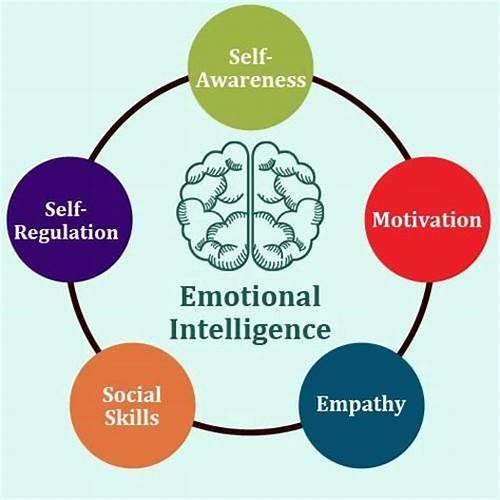Emotional Intelligence (EI), also known as Emotional Quotient (EQ), refers to the ability to identify, understand, manage, and influence one’s emotions as well as the emotions of others. It involves a combination of skills that help people navigate social interactions, manage stress, and make sound decisions. The science behind emotional intelligence is rooted in psychology, neuroscience, and behavioral science.

1. The Key Components of Emotional Intelligence
Emotional intelligence is often broken down into five key components as described by psychologist Daniel Goleman, who popularized the concept in the 1990s:
a. Self-awareness
- This is the ability to recognize and understand your own emotions as they occur. It involves being aware of how emotions can impact thoughts, behavior, and decision-making.
- Neurological basis: Self-awareness stems from the prefrontal cortex, the part of the brain responsible for higher cognitive functions like self-reflection and decision-making.
b. Self-regulation
- Self-regulation refers to the ability to control or manage disruptive emotions and impulses. It involves maintaining calm under pressure and adapting to changing circumstances.
- Neurological basis: Self-regulation is heavily linked to the prefrontal cortex, which helps inhibit impulsive responses, and the amygdala, which processes emotions. A balanced interaction between these regions is key to regulating emotional reactions.
c. Motivation
- Motivation in the context of EI refers to using emotional energy to pursue goals with persistence, enthusiasm, and resilience. It is about staying focused on long-term goals despite challenges or setbacks.
- Neurological basis: Motivation is influenced by areas of the brain related to reward processing, such as the dopamine system. Motivation is also connected to the ventral striatum, which helps drive goal-directed behavior.
d. Empathy
- Empathy is the ability to recognize, understand, and share the feelings of others. It involves being attuned to social cues and understanding others’ emotional states.
- Neurological basis: The mirror neuron system plays a significant role in empathy. This system allows us to “mirror” the emotions or actions of others, which helps in understanding their emotional experiences. The insula and anterior cingulate cortex are also involved in processing emotions related to empathy.
e. Social skills
- Social skills are the abilities to manage relationships and communicate effectively with others. This includes skills like active listening, conflict resolution, and the ability to influence others positively.
- Neurological basis: Social skills engage the prefrontal cortex (for decision-making and social processing) and the amygdala (for emotional reactions), allowing people to interpret and respond appropriately to others’ emotions.
2. The Neuroscience of Emotional Intelligence
The brain regions and processes involved in emotional intelligence work together to allow individuals to navigate emotions in themselves and others. Here are some key areas of the brain involved:
a. Amygdala
- The amygdala is a small almond-shaped structure that plays a central role in processing emotions, particularly fear and threat-related emotions.
- While it’s important for detecting emotional cues, it can sometimes lead to exaggerated emotional responses. For emotional intelligence to function well, it’s crucial that the prefrontal cortex (the “rational brain”) regulates amygdala responses.
b. Prefrontal Cortex
- The prefrontal cortex is responsible for higher-order cognitive functions, such as decision-making, impulse control, and self-reflection.
- It plays a key role in self-regulation and the ability to understand and manage emotional responses. It helps to filter emotional impulses from the amygdala and make more rational decisions based on a balanced view of the situation.
c. Insula
- The insula is involved in processing emotions, empathy, and bodily sensations.
- It helps us recognize our own emotional states and how others may feel, playing a critical role in both self-awareness and empathy.
d. Mirror Neuron System
- Mirror neurons are brain cells that fire both when we perform an action and when we observe someone else performing that action.
- This system is thought to help us “mirror” or empathize with the emotional experiences of others, making it central to empathy and social skills.
3. Emotional Intelligence and the Body
Emotional intelligence doesn’t only involve the brain—it also influences and is influenced by physical states. Heart rate, breathing, and hormonal balance are deeply connected to emotions.
a. Heart Rate and Breathing
- Emotional reactions can affect your heart rate and breathing patterns. For instance, when stressed or anxious, your heart rate increases, and your breath may become shallow.
- Self-regulation can involve controlling these physiological responses through techniques like deep breathing or mindfulness.
b. Hormonal Influence
- Emotions are also mediated by hormones such as cortisol (which is associated with stress) and oxytocin (which is linked to bonding and empathy).
- High cortisol levels can impair emotional regulation, while oxytocin can enhance feelings of empathy and trust, improving social connections.
4. The Impact of Emotional Intelligence on Health and Well-being
Research shows that emotional intelligence has a profound effect on overall health, mental well-being, and performance in various life areas.
a. Mental Health
- People with higher emotional intelligence tend to have better mental health, experiencing lower levels of anxiety, depression, and stress.
- By being able to regulate emotions effectively and empathize with others, emotionally intelligent people are less likely to experience negative emotional states that might lead to mental health issues.
b. Physical Health
- Chronic stress and poor emotional regulation are linked to various health problems, such as high blood pressure, heart disease, and weakened immune function.
- Good emotional intelligence can help buffer against the negative effects of stress and improve physical health by promoting better stress management and emotional regulation.
c. Work and Relationships
- In the workplace, people with high EI tend to have better communication skills, are better at conflict resolution, and work well in teams.
- In personal relationships, EI allows individuals to navigate emotions in both themselves and others, fostering better understanding, connection, and support.
5. Developing Emotional Intelligence
The good news is that emotional intelligence is not fixed—it can be developed over time with conscious effort and practice. Some ways to improve your EI include:
- Self-reflection: Spend time reflecting on your emotions and how they influence your behavior.
- Mindfulness: Practice mindfulness to increase awareness of your emotional responses and reduce impulsivity.
- Empathy exercises: Put yourself in others’ shoes and practice active listening.
- Regulation strategies: Learn and practice techniques like deep breathing, meditation, or cognitive reappraisal to manage stress and emotional responses.
- Feedback: Seek feedback from others about your emotional responses and social interactions to enhance self-awareness.
Conclusion
The science behind emotional intelligence involves a combination of brain processes, hormonal activity, and physiological responses. It plays a crucial role in personal well-being, mental health, relationships, and performance in various areas of life. Understanding and developing emotional intelligence can lead to better emotional regulation, enhanced empathy, improved social skills, and overall resilience in the face of challenges.
